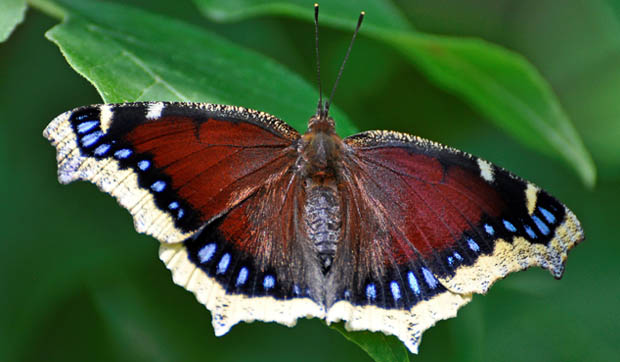Mourning cloak butterflies need to warm up to 50-plus degrees before they can fly. Their dark wings help absorb heat from the sun’s rays and make flight possible. (Photo credit: AcrylicArtist at MorgueFile.com)
Mourning Cloaks
May 5, 2017
Butterflies are easy.
It’s a statement we naturalists make from time to time, and it refers to the fact that we need exert virtually no effort to get people interested in butterflies. Snakes and spiders, on the other hand, are tough, and slime molds are darn near impossible. But butterflies are easy.
So it was the other day when a mourning cloak butterfly suddenly appeared, fluttering along in the spring breeze. I was helping a friend with a prescribed burn on her property when another friend pointed up in amazement as the dark-winged jewel flew gently past. “Surely it’s too early for butterflies,” the friend said. But you know what? It’s not.
What my friend saw was a mourning cloak, Nymphalis antiopa, one of only a handful of butterflies in our area that hibernate as adults. (Other species spend the winter as eggs, larvae or pupae inside chrysalises.) When the days lengthen and temperatures begin to warm, mourning cloaks emerge from their winter shelters and begin their search for first, food, and soon, a mate.
Of these two necessities, food can sometimes be the tougher one to find. Oak tree sap is their preferred food, but isn’t always readily available in early spring. Nectar from early-blooming woodland wildflowers can serve as a fill-in menu item, as can decaying fruit, mineral-rich mud puddles and, believe it or not, animal droppings.
As for that other priority, finding a mate, male mourning cloaks adopt a sit-and-wait approach. They’ll camp out in a sunny clearing and wait for a female to come fluttering by. Eggs are laid on a variety of host food plants, including willows, American elm, cottonwood, aspen, paper birch and hackberry.
Young caterpillars are dark and soon form soft but spiny-looking projections as well as orange spots down their backs. They at first live communally on the host tree but later go on walkabouts and may be found on plants that are not food sources.
Pupation takes place in June and July. What emerges is one of our longest-living butterflies. Mourning cloaks have a life expectancy of nearly one year.
This time of year, in order to be able to fly, adult mourning cloaks must warm their bodies via basking-sitting with wings open, and held at an angle to maximize exposure to the sun. Their dark coloration aids in this endeavor and in fact gave rise to the insect’s common name. Dark brown, almost black, with a line of iridescent spots and a border of bright yellow, the butterfly’s wings were thought to resemble the cloaks worn by people in mourning and thus the common name was formed.
You might think that a mourning cloak would want to stay warm all winter. We do, don’t we? Ah, but we don’t have the chemical makeup of a hibernating butterfly. As temperatures begin to cool in fall, mourning cloaks produce large amounts of sorbitol and other chemicals that serve as natural antifreeze.
People also are tempted to think that butterflies need help finding shelter for the winter. Remember when butterfly houses hit the market a few years back? The thinking was that the tall, decorative boxes with wide slits staggered along the front would provide “habitat” for butterflies needing a place to stay.
Research has since shown that butterfly boxes do indeed make great homes…but not for butterflies. In one study, 40 boxes were examined and found to be home to spiders, wasps, flies, ants and, in one instance, a white-footed mouse. Where were the butterflies? In their natural hibernation spots-under loose tree bark, leaf litter and brush piles.
The researchers concluded that butterfly houses function well as garden ornaments but do little to aid the survival of our native butterfly species. A better tactic for those wishing to help butterflies, said one scientist, would be to build a mud puddle.
Now that’s easy!
Pam Otto is the manager of nature programs and interpretive services at the Hickory Knolls Discovery Center, a facility of the St. Charles Park District. She can be reached at 630-513-4346 or potto@stcparks.org.

